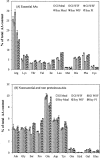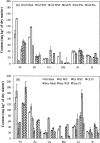Chemical Composition of Defatted Cottonseed and Soy Meal Products
- PMID: 26079931
- PMCID: PMC4469676
- DOI: 10.1371/journal.pone.0129933
Chemical Composition of Defatted Cottonseed and Soy Meal Products
Abstract
Chemical composition is critical information for product quality and exploration of new use. Hence defatted cottonseed meals from both glanded (with gossypol) and glandless (without gossypol) cotton seeds were separated into water soluble and insoluble fractions, or water soluble, alkali soluble as well as total protein isolates. The contents of gossypol, total protein and amino acids, fiber and carbohydrates, and selected macro and trace elements in these products were determined and compared with each other and with those of soy meal products. Data reported in this work improved our understanding on the chemical composition of different cottonseed meal products that is helpful for more economical utilization of these products. These data would also provide a basic reference for product standards and quality control when the production of the cottonseed meal products comes to pilot and industrial scales.
Conflict of interest statement
Figures





Similar articles
-
Chemical Composition and Thermogravimetric Behaviors of Glanded and Glandless Cottonseed Kernels.Molecules. 2022 Jan 5;27(1):316. doi: 10.3390/molecules27010316. Molecules. 2022. PMID: 35011547 Free PMC article.
-
Preparation of an edible cottonseed protein concentrate and evaluation of its functional properties.Int J Food Sci Nutr. 2007 Sep;58(6):486-90. doi: 10.1080/09637480701288488. Int J Food Sci Nutr. 2007. PMID: 17710592
-
Effect of replacing soybean meal protein with protein from upland cottonseed, Pima cottonseed, or extruded Pima cottonseed on production of lactating dairy cows.J Dairy Sci. 2013 Apr;96(4):2374-2386. doi: 10.3168/jds.2012-5723. Epub 2013 Feb 22. J Dairy Sci. 2013. PMID: 23462167
-
Gossypol--a polyphenolic compound from cotton plant.Adv Food Nutr Res. 2009;58:215-63. doi: 10.1016/S1043-4526(09)58006-0. Adv Food Nutr Res. 2009. PMID: 19878861 Review.
-
Feeding cotton products to cattle.Vet Clin North Am Food Anim Pract. 2002 Jul;18(2):267-94. doi: 10.1016/s0749-0720(02)00020-8. Vet Clin North Am Food Anim Pract. 2002. PMID: 12235661 Review.
Cited by
-
Comparison of amino acid digestibility of soybean meal, cottonseed meal, and low-gossypol cottonseed meal between broilers and laying hens.Anim Biosci. 2023 Apr;36(4):619-628. doi: 10.5713/ab.22.0073. Epub 2022 Sep 2. Anim Biosci. 2023. PMID: 36108696 Free PMC article.
-
Preclinical Efficacy and Toxicity Analysis of the Pan-Histone Deacetylase Inhibitor Gossypol for the Therapy of Colorectal Cancer or Hepatocellular Carcinoma.Pharmaceuticals (Basel). 2022 Apr 1;15(4):438. doi: 10.3390/ph15040438. Pharmaceuticals (Basel). 2022. PMID: 35455435 Free PMC article.
-
Molecular mechanism of gossypol mediating CCL2 and IL‑8 attenuation in triple‑negative breast cancer cells.Mol Med Rep. 2020 Aug;22(2):1213-1226. doi: 10.3892/mmr.2020.11240. Epub 2020 Jun 15. Mol Med Rep. 2020. PMID: 32627003 Free PMC article.
-
Multiple strategies to detoxify cottonseed as human food source.Front Plant Sci. 2022 Dec 5;13:1080407. doi: 10.3389/fpls.2022.1080407. eCollection 2022. Front Plant Sci. 2022. PMID: 36544881 Free PMC article. No abstract available.
-
Chemical Composition and Thermogravimetric Behaviors of Glanded and Glandless Cottonseed Kernels.Molecules. 2022 Jan 5;27(1):316. doi: 10.3390/molecules27010316. Molecules. 2022. PMID: 35011547 Free PMC article.
References
-
- Campbell BT, Boykin D, Abdo Z, Meredith WR (2014) Cotton In: Smith S, Diers B, Specht J, Carver B (eds) Yield Gains in Major U.S. Field Crops. American Chemical Society, Madison, WI, p 13–32.
-
- Bellaloui N, Turley RB (2013) Effects of fuzzless cottonseed phenotype on cottonseed nutrient composition in near isogenic cotton (Gossypium hirsutum L.) mutant lines under well-watered and water stress conditions. Front. Plant Sci. 4:516 doi: 510.3389/fpls.2013.00516 - PMC - PubMed
-
- Tazisong IA, He Z, Senwo ZN (2013) Inorganic and enzymatically hydrolyzable organic phosphorus of Alabama Decatur silt loam soils cropped with upland cotton. Soil Sci. 178:231–239.
-
- Pettigrew WT, Dowd MK (2014) Nitrogen fertility and irrigation effects on cottonseed composition. J. Cotton Sci. 18:410–419.
-
- Dowd MK, Wakelyn PJ (2010) Cottonseed: current and future utilization In: Wakelyn PJ, Chaudhry R (eds) Cotton: Technology for the 21st. Century. ICAC Press, Washington D.C., p 437–460.
MeSH terms
Substances
LinkOut - more resources
Full Text Sources
Other Literature Sources

